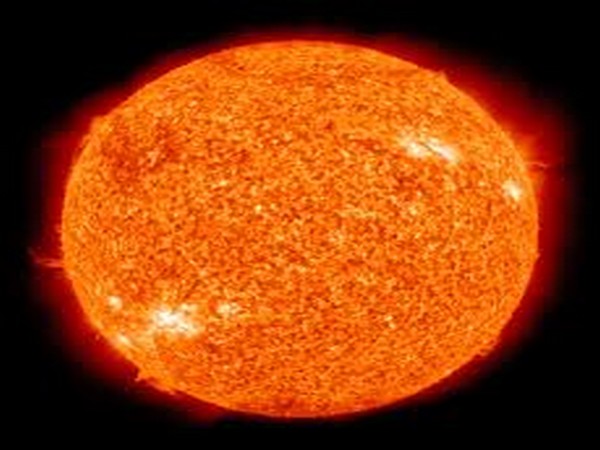GOTTINGEN: Solar activity fluctuates in a rhythm of about 11 years, which is reflected among other things in the frequency of sunspots. A complete magnetic period lasts 22 years. Scientists have long been puzzling over what causes this cycle.
It must be related to the conditions beneath the ‘skin’ of our star: A layer of hot plasma — electrically conductive gas — extends from the surface to 200,000 kilometres below. The plasma within this convection zone is constantly in motion.
A team of scientists from the Max Planck Institute for Solar System Research, the University of Gottingen and New York University Abu Dhabi has now succeeded in drawing the most comprehensive picture of the plasma flows in the north-south-direction to date.
The researchers have found a remarkably simple flow geometry: the plasma describes a single turnover in each solar hemisphere, which lasts for about 22 years. In addition, the flow in the direction of the equator at the bottom of the convection zone causes spots to form closer and closer to the equator during the solar cycle.
The number of sunspots on the visible solar surface varies; sometimes there are more, sometimes fewer. The distance between two sunspot maxima is about 11 years; after 22 years the sunspots are again magnetically polarised in the same way.
During the maximum not only large sunspots appear, but also active regions. In addition, impressive arcs of hot plasma reach far into the solar atmosphere, and particles and radiation are hurled into space in violent eruptions. At the activity minimum, however, the Sun calms down noticeably.
“Over the course of a solar cycle, the meridional flow acts as a conveyor belt that drags the magnetic field along and sets the period of the solar cycle,” said Prof. Dr Laurent Gizon, MPS Director and first author of the new study.
“Seeing the geometry and the amplitude of motions in the solar interior is essential to understanding the Sun’s magnetic field,” he added. To this end, Gizon and his team used helioseismology to map the plasma flow below the Sun’s surface.
Helioseismology is to solar physics what seismology is to geophysics. Helioseismologists use sound waves to probe the Sun’s interior, in much the same way geophysicists use earthquakes to probe the interior of the Earth.
Solar sound waves have periods near five minutes and are continuously excited by near-surface convection. The motions associated with solar sound waves can be measured at the Sun’s surface by telescopes on spacecraft or on the ground.
In this study, Gizon and his team used observations of sound waves at the surface that propagate in the north-south direction through the solar interior. These waves are perturbed by the meridional flow: they travel faster along the flow than against the flow.
These very small travel-time perturbations (less than 1 second) were measured very carefully and were interpreted to infer the meridional flow using mathematical modelling and computers.
Because it is small, the meridional flow is extremely difficult to see in the solar interior. “The meridional flow is much slower than other components of motion, such as the Sun’s differential rotation,” Gizon said.
The meridional flow throughout the convection zone is no more than its maximum surface value of 50 kilometres per hour. “To reduce the noise level in the helioseismic measurements, it is necessary to average the measurements over very long periods of time,” said Dr Zhi-Chao Liang of MPS.
The team of scientists analysed, for the first time, two independent very long time series of data. One was provided by SOHO, the oldest solar observatory in space which is operated by ESA and NASA. The data taken by SOHO’s Michelson Doppler Imager (MDI) covers the time from 1996 until 2011.
A second independent data set was provided by the Global Oscillation Network Group (GONG), which combines six ground-based solar telescopes in the USA, Australia, India, Spain, and Chile to offer nearly continuous observations of the Sun since 1995.
“The international solar physics community is to be commended for delivering multiple datasets covering the last two solar cycles,” said Dr John Leibacher, a former director of the GONG project.
“This makes it possible to average over long periods of time and to compare answers, which is absolutely essential to validate inferences,” he added.
Gizon and his team find the flow is equatorward at the base of the convection zone, with a speed of only 15 kilometres per hour (running speed). The flow at the solar surface is poleward and reaches up to 50 kilometres per hour.
The overall picture is that the plasma goes around in one gigantic loop in each hemisphere. Remarkably, the time taken for the plasma to complete the loop is approximately 22 years — and this provides the physical explanation for the Sun’s 11-year cycle.
Furthermore, sunspots emerge closer to the equator as the solar cycle progresses, as is seen in the butterfly diagram.
“All in all, our study supports the basic idea that the equatorward drift of the locations where sunspots emerge is due to the underlying meridional flows,” said Dr Robert Cameron of MPS.
“It remains to be understood why the solar meridional flow looks like it does, and what role the meridional flow plays in controlling magnetic activity on other stars,” added Laurent Gizon. (ANI)





